This study aims to investigate the effect of errorless motor training on visuomotor behaviors among older adults. We recruited 29 eligible older adults (Mean age = 71.56 years, SD = 4.43), with normal or corrected-to-normal vision, to participate in the study. All participants were trained in the computer-based goal-directed reaching motor task by either errorless motor training, errorful motor training or normal motor training. The specific computer program was written by the Experiment Builder (SR Research, Ontario, Canada) software to control the experimental presentation and to capture the outcome on motor performance. Gaze behaviors were recorded by an EyeLink II desktop mount system (SR Research, Ontario, Canada). It was found that errorful and normal motor training decreased the reaching movement time significantly while errorless motor training had not modified the movement time among older adults in the goal-directed reaching motor task. Also, errorless motor training decreased the reaching distance away from the target (increased movement accuracy) more than normal motor training, while errorful motor training increased the reaching distance. The results indicated that errorless motor training could uniquely improve movement accuracy without modifying movement speed in the goal-directed reaching task. Concerning the gaze behaviors, errorless motor training increased fixation duration on the target together with decreased number of fixation simultaneously, differently from errorful and normal motor training. It suggested that errorless motor training could induce the modification of visual selective attentional processes by increasing fixation duration and decreasing the number of fixations among older adults, which could contribute to focusing more attention on the relevant visual information but neglecting the visual distraction for improving movement accuracy in the goal-directed reaching.
errorless motor training; goal-directed reaching; visuomotor behaviors; visual selective attention; oder adult
Errorless motor training has been employed in different reaching motor tasks [1-4], in which the improvement of motor performance was evidenced. Generally, in errorless motor training, the training would be arranged by increasing the motor task’s difficulty progressively (i.e., from the easy task to difficult task) that attempts to minimize movement errors. The underlying mechanism was found to be related to the nature of errorless motor training in inhibiting the explicit hypothesis-testing processes, due to the minimized movement errors, so that the working memory would be more available for motor control. More specifically, errorless motor training could reduce the involvement of working memory by minimizing movement errors during training. Therefore, the motor performance could be improved because of less hypothesis-testing [1,5,6]. The reduced cognitive loading on the working memory for motor control could decrease the conscious awareness of explicit knowledge about different movement components during movement execution, and consequently prevent the motor skill breakdown [1,7].
As discussed above, errorless motor training could decrease hypothesis-testing [1] due to its effect of minimizing movement errors with low cognitive loading during movement practice [8,9]. Therefore, errorless learners could practice the motor task with relatively lower cognitive demands. Due to the lower cognitive demands for movement practice, errorless learners are believed to have better ability in integrating sensory information and optimizing the perceptual process [4]. Cognitive resources in the working memory that can be released by the errorless motor training could be utilized to reduce the impact of distraction [7] and aging-related decline of working memory [10].
Visual selective attention on a specific target with consciousness could require high loading on the working memory [11-15]. Comparatively, moving object, such as a moving
computer mouse cursor during goal-directed reaching, should also be categorized into the top- down, memory-dependent visual distraction [16]. Top-down processing could be defined as the cognitive process in which the sensory information is proceeded by the brain [17]. Thus, during the computer-based goal-directed reaching task using a computer mouse, it possibly induces competition between the specific reaching target and visual distraction (the moving computer cursor) [18]. This visual strategy of changing the visual attentional processes for motor task execution may be the other way to increase the cognitive load. If individuals cannot be able to optimize the visual attentional processes well (i.e., cannot resist the effect of visual distraction), it could deteriorate motor control and performance consequently. Indeed, previous studies have proved that the change of visual selective attentional processes could increase the cognitive load [19-21]. The modification of visual selective attention could occupy more working memory [22]. Therefore, it is highly possible that the effect of errorless motor training on releasing cognitive resources from working memory could interact with the effect of selective visual attentional processes modulation on increasing demand of cognitive resources on the working memory. However, previous studies have not proved how they possibly interacted.
In the present study, to the best of our knowledge, we represented the first attempt to employ errorless motor training in the training of computer-based goal-directed reaching motor task by older adults. The visuomotor behaviors (including motor performance and gaze behaviors) were quantified to explore the linkage between the potential benefits of errorless motor training on the modification of visual attentional processes to facilitate movement execution. It was hypothesized that errorless motor training could improve the motor performance and adjust the gaze behaviors in the goal-directed reaching motor task among older adults.
Participants
Twenty-nine right-handed eligible older adults were recruited for the study (Mean age = 71.56 years, SD = 4.43). All participants were randomly allocated to either one of the three training groups, Errorful Motor Training Group (N=10), Errorless Motor Training Group (N=10) and Normal Motor Training Group (N=9). Healthy older adults aged 65 or above with normal or corrected to normal vision and met the inclusion criteria of being able to understand and sign consent and had no history of the retina, cerebral vascular disease, Parkinson’s disease or any other neurological impairment were recruited. All of them completed the Chinese version Mini- Mental State Examination (MMSE-C) and obtained the score of more than 24/30. According to the experimental design, all the older adults had experienced to use a computer with a mouse. They all agreed to participate in the study and signed their written informed consent. The study was approved by the Human Research Ethics Committee (HREC) at the University of Hong Kong for ethical clearance for research involving human participants (Reference number: EA 1508010).
Material and apparatus setup
Experimental blocks were presented on the 23-inch computer monitor. All participants handled a computer mouse (Wireless Mouse M185, Logitech Co.) during all reaching tasks. The specific computer program was written by the Experiment Builder (SR Research, Ontario, Canada) software to control the stimulus presentation and response recording. The outcome on motor performance in the computer-based goal-directed reaching motor task was also recorded by this computer program.
Right eye movement was recorded by an EyeLink II desktop mount system (SR Research, Ontario, Canada) at a sampling rate of 500 Hz for the eye. The experimental task’s instructions were displayed in full-screen with a resolution of 1024 by 768 pixels on a 23inch computer monitor. The distance between the monitor and the participants was kept at 70cm from the participants’ center of his/her sternum. The eye tracker was calibrated using the Eyelink II software. It was calibrated using 9 points: one at the screen center position, four at the corners position and four at the mid-points of the four sides of the screen. Mean difference between calibration and validation measurement was kept below 1.5°. The calibration was verified before each session and recalibrated if needed.
With this set up of experimental apparatus, it aimed to assess the research outcomes of motor performance (i.e., movement time, distance away from the target) and gaze behaviors (i.e., fixation duration and fixation count) during the computer-based goal-directed reaching.
Stimuli and procedure
The computer-based goal-directed reaching motor task required the participants to use the computer mouse (Wireless Mouse M185, Logitech Co.) with a cursor on the screen to reach to
the specific target on the computer screen. The target size was changed progressively in the training phase, differently by various motor training methods (i.e., errorful, errorless or normal motor training), and all participants were asked to reach (move the cursor) to the specific target as quick and as accurate as possible. Based on the Fitts’s law, as all participants were requested to reach as quick and as accurate as possible, it was assumed that the smaller the target size participant needed to reach to, the more difficult the reaching motor task was [23-25].
Participants were provided with visual feedback during the motor task, which meant they could see the reaching target and the hand-controlled mouse cursor in the 23-inch computer monitor throughout the whole reaching trials. Participants controlled the computer mouse (Wireless Mouse M185, Logitech Co.) with their right hand in a cover box. By this arrangement, participants could not be able to see his/her hand-controlled computer mouse and therefore it could avoid them from getting visually distracted by their hand position (Figure 1). The entire reaching motor task was arranged as followings (Figure 2): A trial began with drift calibration fixation in the center on a white background. This display followed by a new stimulus array consisting of mouse-controlled cursor “x” in black, starting position with a square in white and a target circle in red. The starting position was in the center of the screen (512,384). The target appeared in a randomly selected direction. Participants were required to control the mouse cursor and moved it to the target center as quick and as accurate as possible. When they reached the target center, they should click the left button of the mouse so that the click position would be the end position for the mouse-controlled cursor.
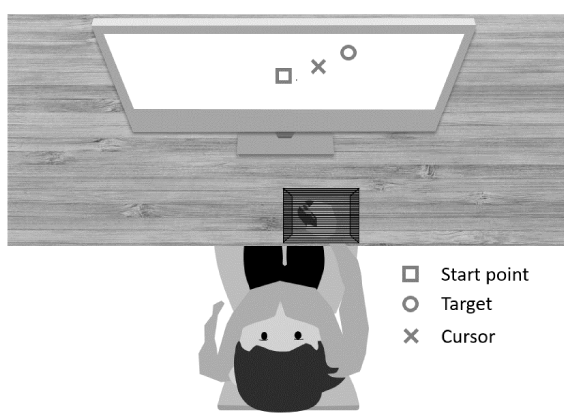
Figure 1. Experimental stimuli and procedure.
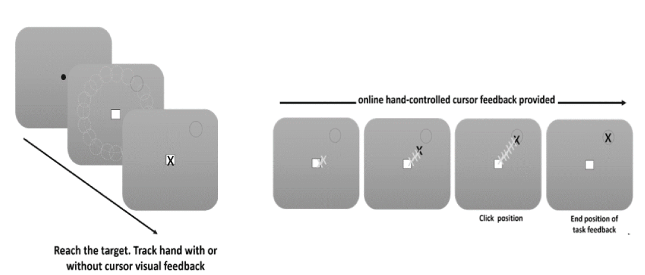
Figure 2. Trials display and visual stimulus process.
Participants were required to complete three experimental phases in order, 20-trial pre- test, 5*20-trial training phase, and 20-trial post-test. All participants were provided a rest for 30 seconds between two experimental phases. Before the formal experimental trials, participants were required to have 20 practice trials to ensure that they could understand the experimental task. The target radius (target size) for reaching was 80 pixels in the pre-test and post-test. 80 pixels were equivalent to a screen distance of 2.117cm as the target radius. The target radius (target size) was changed progressively during the training phase (e.g., 40, 50, 60, 70, 80 pixels). In the Errorful Motor Training Group, the target radius (target size) was changed from small to large target size (i.e., 40, 50, 60, 70, 80 pixels) in five blocks every 20 trials. In the Errorless Motor Training Group, the target radius (target size) was changed from large to small target size (i.e., 80, 70, 60, 50, 40 pixels) in the five blocks every 20 trials. In the Normal Motor Training
Group, the target radius (target size) was changed from 40 to 80 pixels randomly in the five blocks every 20 trials. The target positions of all groups were randomly selected for each trial within one block.
A series of 3x2 training methods (Errorful Motor Training, Errorless Motor Training, Normal Motor Training) x test modes (Pre-test, Post-test) Analysis of Variances (ANOVAs) with repeated measures were used to examine the differences among the three training methods in two different test modes for different main outcome measures of motor performance and gaze behaviors. More specifically, we aimed to evaluate the training effectiveness of different motor training methods in the computer-based goal-directed reaching motor task.
Motor performance
Movement time. Movement time refers to the time (in millisecond) used from a reaching movement onset to termination at the target (mouse clicking position). Shorter movement time after training indicated the faster act or process of movements resulting from training. The main effect of training methods (Errorful Motor Training, Errorless Motor Training, Normal Motor Training) was significant (F (2,537) = 4.308, p=0.014, ηp2=0.016). Also, the main effect of test modes (Pre-test, Post-test) was significant (F (1,537) = 35.673, p<0.001, ηp2=0.062). In addition, there was a significant interaction between training methods and test modes (F (2,537) = 10.544, p< 0.001, ηp2=0.038). The Bonferroni post hoc tests with pairwise and between-group comparisons indicated that participants significantly decreased movement time after taking errorful (p<0.001) and normal (p=0.048) motor training when compared between the pretest and posttest. Errorful trainees conduct the reaching with significantly shorter movement time than errorless (p<0.001) and normal (p=0.005) in the post-test (Figure 3).
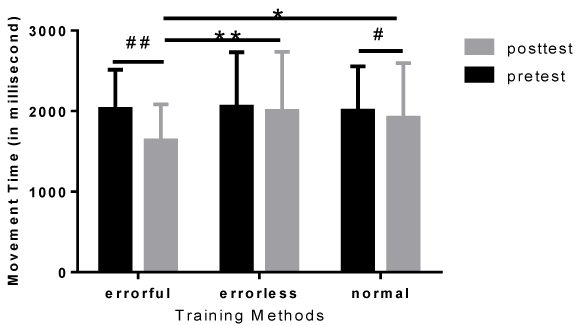
Figure 3. Movement time in pre- and post-test among three training methods (mean with standard deviation); ## represents difference between pre- and post-test is significant (p<.001), # represents difference between pre-and post-test is significant (p<.05), ** represents difference between training methods is significant (p<.001), * presents difference between training methods is significant (p<.05).
Distance away from the target. Distance (in pixel) was defined as the distance between the final computer mouse clicking position and the specific target circle center. The shorter distance away from the target, the more accurately participants completed the goal-directed reaching. The main effect of training methods (Errorful Motor Training, Errorless Motor Training, Normal Motor Training) was significant (F (2,537) = 33.375, p< 0.001, ηp2=0.111). Also, the main effect of test modes (Pre-test, Post-test) was significant (F (1,537) = 5.578, p=0.019, ηp2=0.010). In addition, there was a significant interaction between training methods and test modes (F (2,537) = 13.980, p<.001, η2=0.049). The Bonferroni post hoc tests with pairwise and between-group comparisons showed that errorful trainees (p=0.005) increased distance away from the target while errorless (p<0.001) and normal (p=0.005) trainees decreased the distance away from the target significantly when compared between the pretest and posttest. Errorless trainees conduct shorter distance than errorful (p<0.001) and normal (p<0.001) trainees, and normal trainees conducted shorter distance than errorful trainees (p<0.001) in the posttest. Therefore, errorless trainees conducted the reaching with the shortest distance away from the target while errorful trainees conducted the reaching with the longest distance away from the target in the posttest (Figure 4).
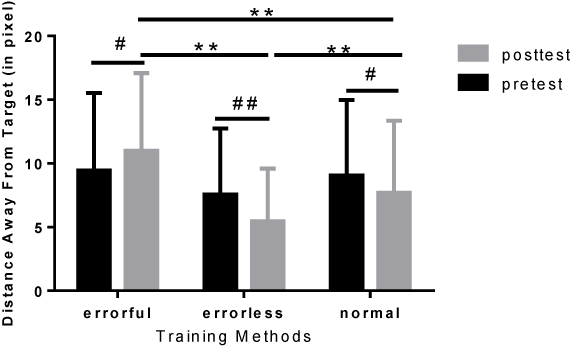
Figure 4. Distance away from target in pre- and post-test among three training methods (mean with standard deviation); ## represents difference between pre- and post-test is significant (p<.001), # represents difference between pre-and post-test is significant (p<.05), ** represents difference between training methods is significant (p<.001).
Gaze behaviors
Fixation duration. Fixation duration (in millisecond) was defined as the amount of time of each fixation, and the fixation has to be longer than 200 milliseconds and shorter than 2000 milliseconds [26]. Longer fixation duration on the reaching target indicated more attention was focused on the target. The main effect of training methods (Errorful Motor Training, Errorless Motor Training, Normal Motor Training) was significant (F (2, 57) = 182.467, p< 0.001, ηp2=0.865). Also, the main effect of test modes (Pre-test, Post-test) was significant (F (1, 57) = 65.727, p<0.001, ηp2=0.536). In addition, there was a significant interaction between training methods and test modes (F (2, 57) = 90.128, p< .001, ηp2=0.760). The Bonferroni post hoc tests with pairwise and between-group comparisons indicated that older adults increased fixation duration after errorless motor training (p<0.001) significantly, while errorful (p<0.001) and normal (p=0.001) trainees decreased fixation duration when compared between the pre-test and post-test. Errorless trainers conducted significantly longer fixation duration on the target than errorful (p<0.001) and normal (p<0.001) trainees in the post-test (Figure 5).
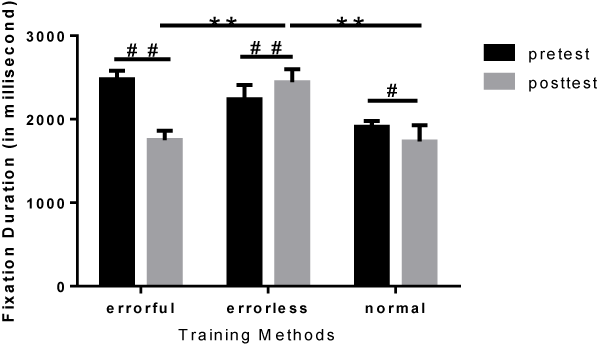
Figure 5. Fixation duration in pre- and post-test among three training methods (mean with standard deviation); ## represents difference between pre- and post-test is significant (p<.001), # represents difference between pre-and post-test is significant (p<.05), ** represents difference between training methods is significant (p<.001).
Fixation count. Fixation count was defined as the frequency that the visual gaze had fixated on the specific location throughout one trial. The more fixations were conducted, the more active searching activities were carried out [27]. The main effect of training methods (Errorful Motor Training, Errorless Motor Training, Normal Motor Training) was significant (F (2, 57) = 12.824, p< 0.001, ηp2=0.310). Also, the main effect of test modes (Pre-test, Post-test) was significant (F (1, 57) = 39.628, p<.001, ηp2=0.410). In addition, there was a significant interaction between training methods and test modes (F (2, 57) = 4.508, p=0.015, η2=.137). The Bonferroni post hoc tests with pairwise and between-group comparisons indicated that the errorful (p<0.001) and errorless (p=0.005) motor training decreased the number of fixations when compared between the pretest and posttest (Figure 6).
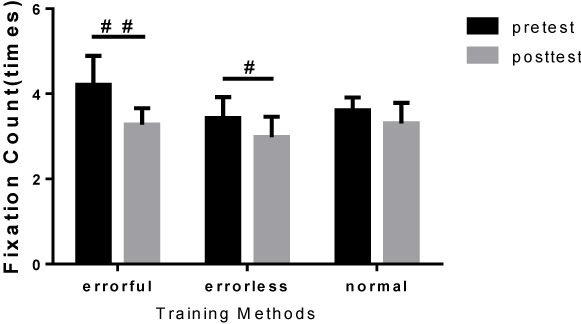
Figure 6. Fixation count in pre- and post-test among three training methods (mean with standard deviation); ## represents the difference between pre- and post-test is significant (p<.001), # represents the difference between pre-and post-test is significant (p<.05).
This study aims to explore whether errorless motor training could modify visuomotor behaviors in the goal-directed reaching among older adults. It was hypothesized that errorless motor training could improve the motor performance and adjust the gaze behaviors in the goal-directed reaching motor task among older adults.
Errorful and normal motor training decreased movement time significantly among older adults in this goal-directed reaching motor task while errorless motor training had not modified the reaching movement time after training. In addition, errorless motor training decreased the reaching distance away from the target (increased movement accuracy) more than normal motor training, while errorful motor training increased the reaching distance.
In the training phase of errorless motor training, trainees were induced to minimize the movement errors due to arrangement the motor task’s difficulty from easy to difficult progressively, which could prevent hypothesis-testing [1,9,28]. This specific training arrangement by errorless motor training could improve movement accuracy without involving much working memory loading due to less hypothesis-testing [1]. However, in the training phase, errorful trainees started the training with the highest difficulty (i.e., the smallest target size) which could induce more movement errors. As training continued, errorful trainees were induced to repeat the process of making movement errors and then correcting it by hypothesis-testing due to the arrangement of the task difficulty. This hypothesis-testing processes could reinforce the explicit knowledge of movement speed and accuracy by consciously realizing errors-made during movement execution [1,28]. Unfortunately, movement accuracy could be deteriorated by the increasing working memory demand due to the hypothesis-testing processes [1]. As a result, the effect of speed and accuracy trade-off by increasing movement speed with decreasing movement accuracy might happen. Therefore, in our study, errorful trainees increased the reaching movement speed but with decreased movement accuracy in the goal-directed reaching motor task after training.
In the goal-directed reaching task, trainees controlled the moving computer mouse cursor and reached to one specific target. The action of aiming and locating the expected target was guided by the top-down modulated visual attention [15]. Furthermore, the computer mouse cursor could act as a moving hand-control object and could be regarded as a distractor. It could distract the attention from the target in the goal-directed reaching task [16]. In the goal-directed motor task, participants with errorless motor training could selectively ignore the visual distraction but focus on the task-relevant information [29]. It could reduce the competitive relationship on top-down modulation attentional distribution between the target and mouse moving cursor [18] as this competitive activity in the visual selective attentional processes may increase cognitive load on the working memory [15,22,30].
Eye movement unconsciously changes according to the demands of attention during the visual activity [31]. The amount of attention could be assessed by measuring fixation duration [32,33], which is also used to be an index of online cognitive processing [34]. The overall number of fixations in one trial (fixation count) is thought to be correlated with search efficiency negatively. More fixations on the specific target indicated less efficient to search potential target resulting from a poor arrangement of stimuli components [35]. In our study, errorless motor training increased fixation duration on the reaching target significantly, differently from errorful and normal motor training. Also, errorful and errorless motor training decreased the number of fixations significantly. This results indicated that errorless motor training could distinctively increase the fixation duration together with decreasing fixation count on the reaching target simultaneously. It implies that errorless trainees concentrated more on the target with effective visual searching during the goal-directed reaching. It was speculated that errorless motor training was more likely to facilitate trainees to conduct visual selective attention on target rather than the moving cursor. Therefore, errorless motor training was believed to be able to modulate visual selective attentional processes which could contribute to concentrating more attentional focus on the relevant visual information but neglecting the irrelevant visual distraction during goal- directed reaching.
Motor control may become ineffective among the ageing population in both peripheral and central nervous system, which leads to many motor problems [36]. Due to the low working efficiency of the muscles and bones in the motor system among older adults, the process of movement execution may become slow and unstable [37]. Older adults may have problems in daily life because of the ageing-related motor problem (e.g., reduced movement speed, increased movement variability, and instability) [38], decreased directional sensitivity of balance [39], decreased muscle strength [40], and coordination difficulties between motor and different sensory systems [41]. Ageing problems are more likely to affect older adults in deteriorating movement control due to ageing and poor visuomotor coordination. Visuomotor adaptation has been reported to be one of the most effective methods to make individuals modulate coordination of motor and visual systems to compensate for viusomotor coordination difficulties [42]. Therefore, errorless motor training, which aimed to prevent the accumulation of explicit knowledge during movement execution, could be regarded as a potential training method to obtain motor benefit through visuomotor adaptation and be more effective among older adults. Errorless motor training could indeed be considered as one of the rehabilitative approaches for viusomotor rehabilitation in the aging population.
Errorful and normal motor training decreased the reaching movement time significantly while errorless motor training had not modified the movement time among older adults in the goal- directed reaching motor task of our present study. Errorless motor training decreased the reaching distance away from the target (increased movement accuracy) more than normal motor training, while errorful motor training increased the reaching distance. The result suggested that errorless motor training could uniquely improve movement accuracy without modifying movement speed, differently from errorful and normal motor training. Also, errorless motor training increased fixation duration on the target together with decreased the number of fixations significantly, differently from errorful and normal motor training. This result suggested that errorless motor training could induce the modification of visual selective attentional processes by increasing fixation duration and decreasing the number of fixations among older adults, which could contribute to concentrating more on the relevant visual information but neglecting the visual distraction for motor control. Further research could be considered to investigate the effect of errorless motor training in different motor tasks, especially the complicated motor tasks which rely heavily on the working memory capacity.
The authors would like to express their gratitude to Miss May Leung, Miss Cynthia Choi, Miss Debbie Chan for their assistance in the study. Part of the initial version of this manuscript is a chapter of the Ph.D. thesis submitted in part requirement for the degree of Doctor of Philosophy at the University of Hong Kong by the first author. The work described in this manuscript was not supported by any financial grants or other funding. The author(s) declared no potential conflicts of interest with respect to the research, authorship, and/or publication of this article.
- Maxwell JP, Masters RS, Kerr E, Weedon E (2001) The implicit benefit of learning without errors. Q J Exp Psychol A 54: 1049-1068. [Crossref]
- Buszard T, Reid M, Masters R, Farrow D (2016) Scaling the Equipment and Play Area in Children's Sport to improve Motor Skill Acquisition: A Systematic Review. Sports Med 46: 829-843. [Crossref]
- Buszard T (2014) Scaling sporting equipment for children promotes implicit processes during performance. Consciousness and cognition 30: 247-255.
- Capio CM, Poolton2021 Copyright OAT. All rights reserv(2013) Reducing errors benefits the field-based learning of a fundamental movement skill in children. Scand J Med Sci Sports 23: 181-188. [Crossref]
- Maxwell JP, Masters RS, Eves FF (2003) The role of working memory in motor learning and performance. Conscious Cogn 12: 376-402. [Crossref]
- Lam W (2008) The attentional demands of implicit motor learning.
- Poolton JM, Masters RS, Maxwel JP (2005) The relationship between initial errorless learning conditions and subsequent performance. Hum Mov Sci 24: 362-378. [Crossref]
- Koehn JD, Dickinson J, Goodman D (2008) Cognitive demands of error processing. Psychol Rep 102: 532-538. [Crossref]
- Lam WK, Maxwell JP, Masters RS (2010) Probing the allocation of attention in implicit (motor) learning. J Sports Sci 28: 1543-1554. [Crossref]
- Reijnders J, van Heugten C, van Boxtel M (2013) Cognitive interventions in healthy older adults and people with mild cognitive impairment: a systematic review. Ageing Res Rev 12: 263-275. [Crossref]
- Carmi R, Itti L (2006) The role of memory in guiding attention during natural vision. J Vis 6: 898-914. [Crossref]
- Hayhoe M, Ballard D (2005) Eye movements in natural behavior. Trends Cogn Sci 9: 188-194. [Crossref]
- Navalpakkam V, Itti L (2005) Modeling the influence of task on attention. Vision Res 45: 205-231. [Crossref]
- Kastner S, Ungerleider LG (2000) Mechanisms of visual attention in the human cortex. Annu Rev Neurosci 23: 315-341. [Crossref]
- Cohen MA, Cavanagh P, Chun MM, Nakayama K (2012) The attentional requirements of consciousness. Trends Cogn Sci 16: 411-417. [Crossref]
- Miles JD, Proctor RW (2015) Attention is captured by distractors that uniquely correspond to controlled objects: An analysis of movement trajectories. Atten Percept Psychophys 77: 819-829. [Crossref]
- Corbetta M, Shulman GL (2002) Control of goal-directed and stimulus-driven attention in the brain. Nat Rev Neurosci 3: 201-2015. [Crossref]
- Gozli DG, Bavelier D, Pratt J (2014) The effect of action video game playing on sensorimotor learning: evidence from a movement tracking task. Hum Mov Sci 38: 152-162. [Crossref]
- Koch C, Tsuchiya N (2012) Attention and consciousness: related yet different. Trends Cogn Sci 16: 103-105. [Crossref]
- Railo H, Koivisto M, Revonsuo A (2011) Tracking the processes behind conscious perception: a review of event-related potential correlates of visual consciousness. Conscious Cogn 20: 972-983. [Crossref]
- Lamme VA (2004) Separate neural definitions of visual consciousness and visual attention; a case for phenomenal awareness. Neural Netw 17: 861-872. [Crossref]
- Koch C, Tsuchiya N (2007) Attention and consciousness: two distinct brain processes. Trends Cogn Sci 11: 16-22. [Crossref]
- Fitts PM (1954) The information capacity of the human motor system in controlling the amplitude of movement. J Exp Psychol 47: 381-391. [Crossref]
- Fitts PM (1992) The information capacity of the human motor system in controlling the amplitude of movement. J Exp Psychol 121: 262.
- Boritz J, Cowan WB (1991) Fitts's law studies of directional mouse movement. human performance 1.
- Nikolaev AR, Jurica P, Nakatani C, Plomp G, van Leeuwen C (2013) Visual encoding and fixation target selection in free viewing: presaccadic brain potentials. Front Syst Neurosci 7: 26. [Crossref]
- Williams AM, Davids K, Burwitz L, Williams JG (1994) Visual search strategies in experienced and inexperienced soccer players. Res Q Exerc Sport 65: 127-135. [Crossref]
- Masters and Poolton, Advances in implicit motor learning. Skill Acquisition in Sport: Research, Theory and Practice, 2012: p. 59.
- Wahn B and König P (2017) Is attentional resource allocation across sensory modalities task- dependent? Adv Cogn Psychol 13: 83-96. [Crossref]
- Awh E, Vogel EK, Oh SH (2006) Interactions between attention and working memory. Neuroscience 139: 201-208. [Crossref]
- Unema PJ (2005) Time course of information processing during scene perception: The relationship between saccade amplitude and fixation duration. Visual cognition 12: 473-494.
- Castelhano MS, Mack ML, Henderson JM (2009) Viewing task influences eye movement control during active scene perception. J Vis 9: 6-6. [Crossref]
- Henderson JM (2007) Regarding scenes. Current directions in psychological science 16: 219-222.
- Nuthmann A, Henderson JM (2010) Object-based attentional selection in scene viewing. J Vis 10: 20. [Crossref]
- Kotval XP, Goldberg JH (1998) Eye movements and interface component grouping: An evaluation method. in Proceedings of the Human Factors and Ergonomics Society Annual Meeting. SAGE Publications Sage CA: Los Angeles, CA.
- Ketcham CJ, Seidler RD, Van Gemmert AW, Stelmach GE (2002) Age-related kinematic differences as influenced by task difficulty, target size, and movement amplitude. J Gerontol B Psychol Sci Soc Sci 57: 54-64. [Crossref]
- Brooks SV, Faulkner JA (1994) Skeletal muscle weakness in old age: underlying mechanisms. Med Sci Sports Exerc 26: 432-439. [Crossref]
- Darling WG, Cooke JD, Brown SH (1989) Control of simple arm movements in elderly humans. Neurobiol Aging 10: 149-157. [Crossref]
- JHJ Allum, MG Carpenter, F Honegger, AL Adkin, and BR Bloem (2002) Age-dependent variations in the directional sensitivity of balance corrections and compensatory arm movements in man. J Physiol 542: 643-663. [Crossref]
- Dubost V (2005) Decreased trunk angular displacement during sitting down: an early feature of aging. Physical therapy 85: 404-412.
- Bennett PJ, Sekuler R, Sekuler AB (2007) The effects of aging on motion detection and direction identification. Vision Res 47: 799-809. [Crossref]
- Wong T, Henriques DY (2009) Visuomotor adaptation does not recalibrate kinesthetic sense of felt hand path. J Neurophysiol 101: 614-623. [Crossref]






